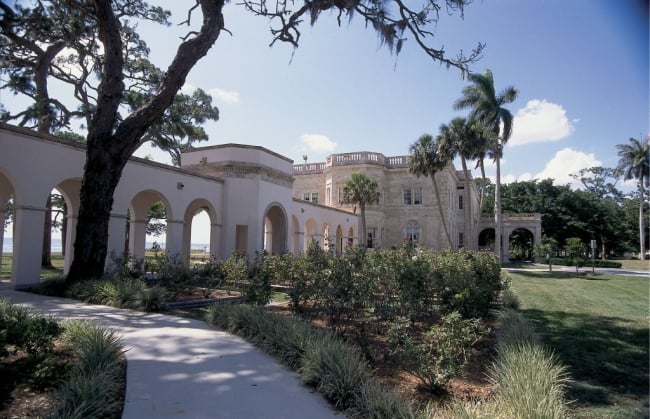You have /5 articles left.
Sign up for a free account or log in.

Independent Picture Service/Universal Images Group/Universal Images Group Editorial/Getty Images
New College of Florida
Last April, California Governor Gavin Newsom flew to Sarasota to visit with students from New College of Florida. Newsom was in Florida to condemn Governor Ron DeSantis’s conservative overhaul of the progressive public college, including the elimination of the office of diversity, equity and inclusion. While I empathize with the situation New College students and faculty members find themselves in, when a spokesperson for DeSantis called Newsom’s visit a “stunt,” I had to agree.
DeSantis’s hijacking of the leadership of New College drew predictable condemnation from both mainstream and education journalists, but little has been mentioned over the past year about how unusual New College was in the first place. The Florida government’s interference in the operation of the college is particularly egregious because of the value of what was lost.
A very brief history: The densest concentration of small liberal arts colleges is in the Northeast, because that is where there were enough students to support the creation of colleges like Williams and Bowdoin in the 1790s. Most of those then-new colleges were small, religious, male and private. As the population shifted toward the Southwest in the twentieth century, large public universities became the norm, culminating in 1960 with Clark Kerr’s “Master Plan” for higher education in California. This evolution of American higher education left little room for small public colleges, and therefore relatively few of those exist. Florida has one. California arguably does not.
There are a handful of small public liberal arts colleges scattered around the country from Maryland to Washington State. Several of them, including New College, were created in the 1960s in response to both social change and huge numbers of Baby Boomers entering higher education (the motto of Evergreen State College, founded in 1967, is still “Let it all hang out”). The closest thing California has to a small public college is Sonoma State University, which was founded in 1961 along the same lines as Evergreen and which now enrolls roughly 6,000 students. Evergreen still has only about 2,000. Massachusetts College of Liberal Arts has about 1,000, and New College has approximately 700.
Unfortunately, it was not simply the case that California experienced massive growth in the second half of the twentieth century and its small colleges became medium-sized. In 1966, California elected Ronald Reagan as governor, and he quickly went to war against “big education” by ending free tuition, limiting free speech, calling for annual budget cuts, and firing Kerr, whose plan had created the world-famous system of University of California and California State University campuses. When Newsom told students in Florida “I can’t believe what you’re dealing with. It’s just an unbelievable assault,” he was forgetting the history of his own state. Reagan’s argument that California “should not subsidize intellectual curiosity” makes DeSantis’s assault on academic freedom entirely believable. One question we should all be asking is, “How far are today’s Republican politicians willing to go in their war against education?” And also, “Will Democrats do anything to defend education?”
Gavin Newsom was not even two years old when Reagan sent the National Guard to teargas students at Berkeley whom he called “cowardly fascists,” but that assault was filmed, and the footage is on YouTube. As Reagan famously said regarding the quelling of student protesters, “If it takes a bloodbath, let’s get it over with.” About a month after he said that, the National Guard murdered four students at Kent State.
Reagan’s behavior helped sweep him into the White House ten years later, but damaged California’s system of higher education for generations. Instead of just describing DeSantis as “unbelievable” when his behavior so far suggests a watered-down version of Reagan’s, what if Newsom modeled a positive alternative?
Today’s college students look different than their Boomer forebears, and public higher education should meet the needs of today’s students, not the students of fifty years ago. Small colleges are a good fit for many students, including first-generation students who benefit from smaller class sizes, closer relationships with faculty, a focus on teaching over research, and interdisciplinary, flexible curricula. There are more of these students today than when Reagan was governor fifty years ago. Why do Reagan’s ideas about austerity still hold sway even in blue states, rebranded as “tolerable suboptimization” at University of California, Merced? Why not reverse course and create, instead of destroying?
Small liberal arts colleges are also good for creatives and entrepreneurs, and the California economy relies on those. Robert Noyce, nicknamed “the mayor of Silicon Valley” after inventing the microchip and founding Intel, graduated from Grinnell College in Iowa, which has 1,700 students. The list of Hollywood writers, actors and directors who graduated from small colleges is too long to include here.
The political right’s response to the idea of starting a new college will, of course, be that “we can’t afford it.” California has the fifth largest economy in the world, so it does have money to spend on the things the state considers priorities. For example, Newsom’s most recent proposed budget calls for more than $18 billion for prisons; the state spends more than $132K per prisoner per year. If California prioritized education as much as incarceration, Governor Newsom could celebrate his state’s accomplishments, rather than just condemning his Floridian counterpart.
In fact, California does have something wonderful to celebrate, because it is home to a small liberal arts college that, while independent, operates inside a public building. Mount Tamalpais College is tuition free, fully accredited, and enrolls only about 300 in-state students. Textbooks and school supplies are free, and the college even comes with free room and board, because Mount Tam is located within San Quentin Prison. A small number of incarcerated students have access to a kind of education not available to the general population of California.
What would a new New College look like in California? Is Newsom willing to guarantee freedom from political interference? Could the campus be an adaptive reuse of a closed military property? Could it occupy a vacant office tower? Most importantly, is the world’s fifth-largest economy radical enough to offer free tuition, as it did 60 years ago?
Colleges are interesting from a public planning standpoint because, unlike tech startups (to use a relevant example), they are more than one thing. While their primary mission is education, colleges are also employers, provide housing, operate sports programs and run public transportation systems. Because colleges are so multifaceted, they can help solve many problems at once. What other challenges is California facing that a college might help alleviate? Affordable housing? Colleges can provide housing for both students and employees. Traffic? Colleges are famously walkable communities. Migration of Californians to other states? Colleges are magnets for attracting and retaining talented people (see: Boston). Immigration from other countries? What better mechanism for helping recent immigrants acclimate and succeed than education?
Newsom attacking DeSantis for his interference with New College is perfectly justified, but wouldn’t it be great if Newsom’s base could point toward what California is doing well, and not simply condemn what Florida is doing poorly?








